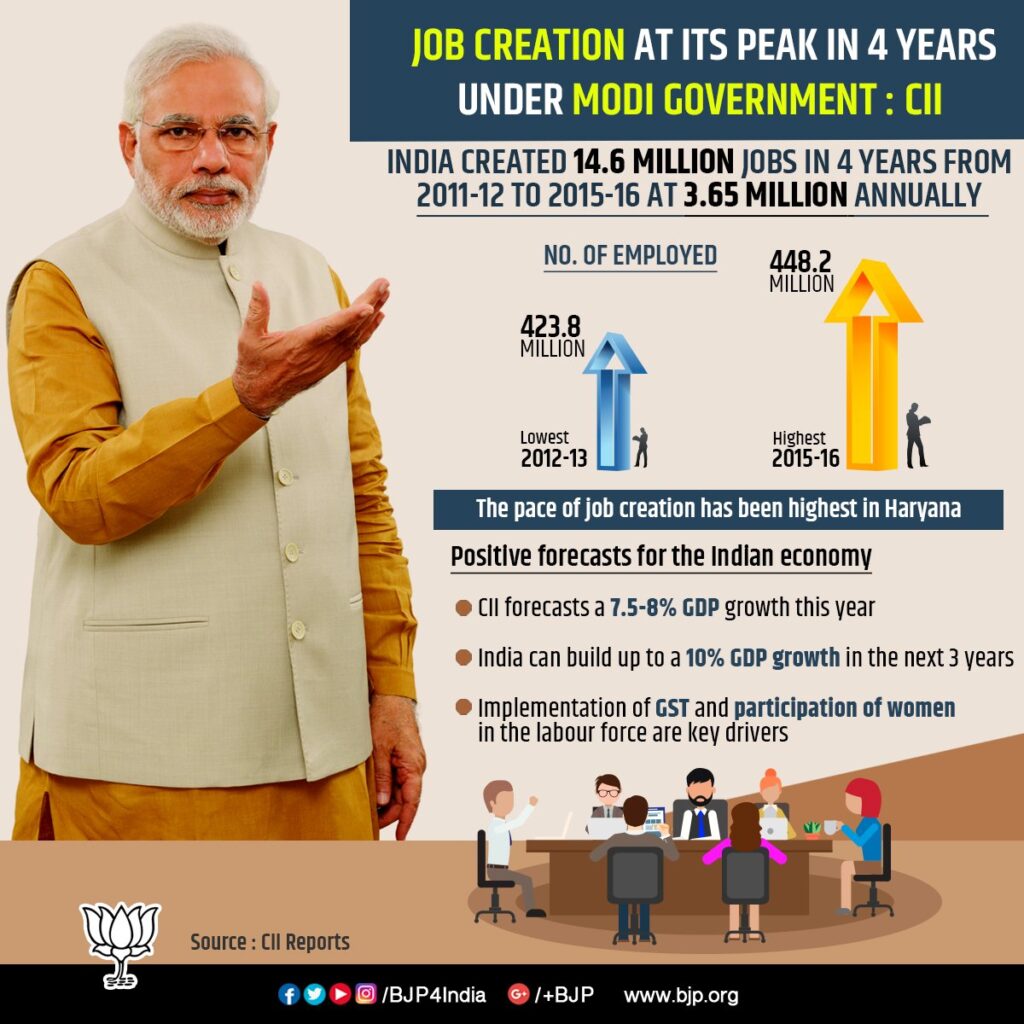By Dr. Gyan Pathak
In less than a week after the presentation of the Union Budget 2025-26, the Government of India led by Prime Minister Narendra Modi, had to announce two specific measures – first for the Decent Job Generation Employment Linked Initiative schemes and the second for the Skill India Programme – signifying the tragic failure for both the flagship programmes of the Centre to resolve the great twin crisis of jobs and skills.
Union Budget 2025-26 was tabled on February 1, 2025, and Union Minister for Finance Nirmala Sitharaman had laid out the tenets for Developed India (Vikasit Bharat) by 2047 one of which was “hundred per cent skilled labour with meaningful employment”. On February 6, EPFO under the Union Ministry of Labour and Employment had to extend the deadline for employers for UAN activation and Aadhaar seeding of bank accounts of all the employees till February 15, 2025, so that Employment Linked Initiative (ELI) scheme worth Rs10,000 announced in the Union Budget 2024-25 could be implemented. In other words, the scheme is yet a non-starter while the current financial year is going to end on March 31, 2025. Union Budget for the next fiscal 2025-26 has doubled the budget to Rs 20,000 crore for ELI scheme, which government could not start until now, two of the reasons being – Centre not even ready with the programme details, and employers are hesitant on joining this programme.
In her Union Budget 2024-25, Sitharaman has brought this ELI scheme for decent job generation in the country, since India has been failing increasing decent jobs, and of late the country has been witnessing sharp rise in informal jobs both in informal and formal sectors. Earlier data showed over 90 per cent of the India’s workforce in informal jobs, but AITUC leaders have been claiming it has risen to about 97 per cent. Even the government Periodic Labour Force Survey (PLFS) for 2023-24 shows that excluding agricultural labour force, there were around 73.2 per cent workers were informal. Even among counted as employed, 19.4 per cent are in unpaid employment. A total of 58.4 per cent of the total employed people in 2023-24 were self-employed, majority of them are in fact unemployment in disguise. Similar is the cast with agricultural labour with very low wages. Regular wage and salaried jobs in India in 2023-24 were only 21.7 per cent only.
It is in this backdrop, when Union Finance Minister in her budget speech of 2025-26 said about meaningful employment with 100 per cent skill, it was very pleasing to the ear, but had no significant financial support for that despite the failure of even launching the ELI for announced decent job generation. EPFO has been just extending the last date of completing the deadline for employers for UAN activation and Aadhaar seeding of Employees bank accounts.
When the Skill India Mission was launched in 2025 under a newly formed Union Ministry of Skill Development and Entrepreneurship, it was said that majority of the workforce were unemployed due to very low level of skilling and 4 per cent of the workforce rendering majority of them unemployable in current context of type of availability of jobs. Union government said that they would make job seekers employable with suitable skills and would train 40 crore people by 2022 in various skills. The key initiatives were National Skill Development Mission (NSDM), National Policy for Skill Development and Entrepreneurship, Pradhan Mantri Kaushal Vikas Yojana, and Skill Loan Scheme. However, the Skill India Mission miserably failed.
There was no option left with the government but to restructure the Skill India Mission keeping in view the projected skill shortage by ILO long back in 2019, which said that India was heading towards a shortage for skill gap of 29 million by 2030. Accenture in 2019 had predicted that if India did not take timely actions—such as investing in new technologies or building industry-required skills—the skill deficit could cost the country US$ 1.97 trillion in terms of gross domestic product (GDP) over the next decade.
Skill gap has since been worsened. The dimension of the Crisis can just be imagined that the Global Talent Shortage Survey 2025 has said that 80 per cent of employers in India are struggling to find out the right talent for works available. Nevertheless, Union Ministry of Labour and Employment has said that the percentage of skilled workforce in India in 2024 has risen to 51.3 per cent of the total workforce, claiming that they have become employable now.
Union Government has been distributing skills certificates that has little relevance in the job market, in which even certified skilled people are not finding jobs, while employers not finding really skilled talent for available jobs. Huge skill mismatch has become serious part of the twin jobs-skills crisis.
Under the skilling network of India, there are 13,818 training centres including PMKK’s under PMKVY, 288 JSS centres, 49927 NAPS Establishments, and 15,016 ITIs under CTS. PMKVY since its inception to September 2024 had trained only 13,724,226 people, JSS since inception to September 2024 trained 26,38,028 people, NAPS (Since 2018-19 to October 2023) trained 25,48,023 people, and CTS (2018-19 to 2022-23) trained 65,10,839 people. All these show a long journey ahead.
Sitharaman said about 100 per cent skilling of our work force with meaningful employment in her budget speech, but India has so far failed in its Skill India Mission, and not even succeeded in restructuring it yet, that has started in 2023-24. The name was changed to Skill India Programme and an allocation of Rs 2278.37 crore was made in the 2023-24 budget. The three key schemes of the restructured Skill India Programme are PMKVY 4.0, PM NAPS, and JSS, that have jointly benefited only over 2.27 crore people so far, even with the skills that are irrelevant in the contemporary job market.
The reasons for failure in skill front can also be seen through the budget expenditure. Though the Skill India Programme got budget allocation of Rs 2278.37 crore in 2023-24 it actually spent only Rs 1300.50 crore. As against the allocation of Rs 2685.64 crore in 2024-25 the revised estimate shows expenditure of only Rs 2318.00 crore. Now for 2025-26 the Skill India Programme has been allotted Rs 2700 crore.
The first mystery is why such low allocations are being made in meaningful skilling of the people of the country? The second is mystery is why even the low allocation are not being utilised. Now a third mystery has been added to it on February 7, only in less than one week of budget presentation, when Union Cabinet chaired by Prime Minister Narendra Modi approved an ‘overlay outlay’ of Rs 8,800 crore over three times the budget allocation for 2025-26 boasting of continuation and restructuring of Skill India Programme.
The question is why such a huge amount was not part of the Union Budget 2025-26 presented just a week ago? Another question arises from the period for which the ‘overlay outlay’ was approved which covers the period of 2022-23 to 2025-26. Three years have been past, and now Centre came to know that they need to make additional outlay for the years that were past, that too after the budget presentation. Since the years past are passed, no amount of money additionally given now can create a single more person skilled. As for the allocation for the year 2025-26, it was meagre Rs 2700 crore, why? Especially when Centre has come out with Rs 8,800 crore of additional allocation?
If it is the way of planning, implementation, and spending in various programmes for generating jobs in general, and decent job generation in particular, and also in skilling the workforce of the country, the twin crisis of job generation and skilling is to continue. India, must take the crisis more seriously to avoid more tragic consequences than what is at present. We must keep in mind that we need more relevant skilling in fast changing technology driven job market. (IPA Service)

 India’s $5-Trillion-Economy Dream By 2025 Has Gone Awry
India’s $5-Trillion-Economy Dream By 2025 Has Gone Awry 